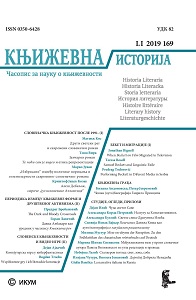На путу за Константинопољ: чешки путописци на Балкану
On the Way to Constantinople – Czech Travel Writers in the Balkans
Author(s): Aleksandra Korda-PetrovićSubject(s): Comparative Study of Literature, Czech Literature
Published by: Институт за књижевност и уметност
Keywords: Czech travelogue;Trajan’s road;Ottoman Empire;Balkans;Václav Budovec of Budova;Václav Vratislav of Mitrovic;Heřman Černín z Chudenic;travelogue “mental maps”;stereotypes;
Summary/Abstract: The 17th-century Czech travelogues, written in Latin and Czech, by Václav Budovec of Budova (Anti-alkorаn, 1614), Václav Vratislav of Mitrovic (The Experiences of Václav Vratislav of Mitrovic, which he had in the Turkish capital Constantinople, encountered in his imprisonment in 1591 and recorded upon his happy return in 1599) and Heřman Černín z Chudenic (Diary of 1645) are testimonies of the beginnings of creating a stereotypical image of the Balkans, which the following Czech travel writers would adopt. As members of the Hungarian diplomatic missions, they recorded their adventures, impressions and thoughts in the form of religious polemics, adventure writings and diary entries. The lands, peoples and customs which these Czech travel writers encounter on their way to Constantinople are viewed as the province of the mighty Ottoman Empire, and the people living there are described as subjugated and “en-route”. The travel writers often do not make any ethnic differences and do not offer a broader picture of the regions they pass, but only describe what they see in the vicinity of the Trajan’s road. Their goal is Constantinople and they are focused on it. Their image of the Balkans, which they still do not name so, is blended into the image of the Ottoman Empire. The Turkish empire is presented as powerful, belligerent and dangerous. On his way to Constantinople the traveler encounters many dangers, he needs protection and escort, he could get ill or end up in prison. This is what gradually shapes a stereotype of the whole Balkan region which is experienced as the area characteristic for the Ottoman heritage. The 19th-century Czech travel writers, Vítězslav Hálek and Jan Neruda recorded their observations from their trip to Tsargrad much later than the first Czech travelers to Constantinople. The different historical circumstances changed the angle of their views of the Balkans and the form of their records itself had come a long way in the travel-writing genre development. Their travel feuilletons, however, follow the existing “mental maps” of the earlier travel writers and convey the picture of the Balkans as an exotic destination which they regard as a region where the European and Oriental cultures are intertwined and where the tradition of the Ottoman heritage is predominant.
Journal: Књижевна историја
- Issue Year: 51/2019
- Issue No: 169
- Page Range: 281-297
- Page Count: 17
- Language: Serbian

